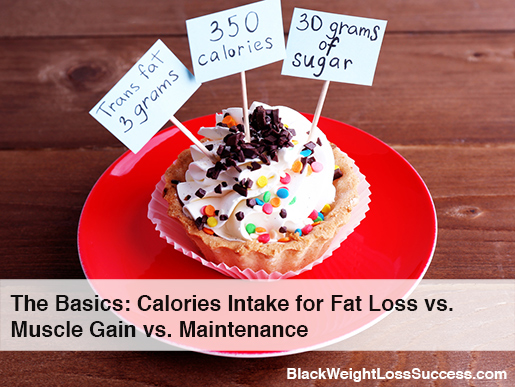
This article breaks down the basics of calorie counting.
When you’re interested in weight loss and muscle gain, learning about all about calories and learning about nutrition in general will serve you well. Calories are the essential units of energy that are found in all foods and are necessary in maintaining the body’s function. According to many fitness and nutrition specialists, “calories in, calories out” (CICO) is very important when it comes to getting to and maintaining a certain goal weight. In fact, many advocates of this concept assert that those who are overweight simply ingest too many calories. I disagree, because eating too many junk food calories isn’t exactly the same as eating a lot of lean protein and healthy carbs when it comes to health…and health is really the ultimate goal, right?
I personally believe that considering calories is important, but you also have to consider what types of foods you are eating. Counting grams of carbs, fat, protein, sugar and salt is key to reaching your goal weight. (more info on that) Having a percentage goal in mind is very helpful for creating balanced meals, for example; 35% carbs, 35% protein, 30% fat.
| Carbohydrates | 4 calories per gram |
| Fat | 9 calories per gram |
| Protein | 4 calories per gram |
The good news is that in general, counting calories is a great way of monitoring weight loss, muscle gain, and also weight maintenance. In this article, I will give you a general understanding of counting calories for fat loss vs. muscle gain vs. maintenance.
Counting Calories for Fat Loss
Anyone who is looking to lose weight should find out how many calories are recommended for their age, height, and weight (BMR), keep track of their calories daily, and decrease the total calories they have been eating by 400 – 700 per day. You can use you Basal Metabolic Rate as a guide to figure out that initial number of calories that is allowing you to maintain your current weight. The 400-700 calorie reduction is called a caloric deficit.
Caloric deficit is essential in fat loss because it helps you maintain the energy you need to function but still lose excess fat. You don’t want your calorie intake to drop too low, especially when you’re exercising regularly, because it can cause the body to become catabolic. That means that it will break down muscle tissue to get the fuel it needs. The metabolism can also move slower when you aren’t getting enough food because the body will try to conserve energy. Eating too few calories is one of the main reasons people see their weight loss slow down on restriction diets after the first couple of weeks or first month.
The most common way of losing fat is by subtracting 500 calories from your normal intake/BMR, which means that if your daily consumption to maintain your weight is 2000 calories, you need to reduce it to 1500 in order to lose fat. It takes burning 3500 calories to lose one pound, so over the course of a week you’ll be reducing your calorie intake a total of 1 pound of energy, thus you’ll be able to lose weight. The amount of deficit you use will depend on your current BMR and current weight. If you weigh 120 pounds you don’t’ likely want to cut 500 calories from your diet. If you weight 400 pounds, you may be able to use a larger calorie deficit without your body seeking muscle for fuel.
More info on where to start – What is your BMR?
Counting Calories for Muscle Gain
This is information for those who are at their goal weight. If you are already eating more that what is suggested to maintain your weight focus on fat loss first and incorporate weight training into your routines to build muscle.
Unlike counting calories for weight loss, counting calories to gain muscle requires a caloric increase. For one to gain muscles, you typically have to add 200-500 calories to your normal intake (BMR, current calorie goals based on workouts, etc.) and for those who can barely put on any weight, you might have to add more than 500 calories. Everyone is different, so it’s a trial and error game. The human body utilizes about 60% of calories in order to keep up with the normal functioning of the body, so you don’t want to over do it and cause weight gain.
The fact that your body needs extra energy to build muscle can make it hard to lose fat and build muscle at the same time. That is why you will see many bodybuilders talk about cutting, i.e. fat loss, and building, i.e building up muscle. They usually plan to do these things at different times, because some muscle loss can happen when you cut calories and nutrients to lose fat. When you increase your intake of calories, be sure that the calories are healthy calories (eggs, veggies, whole grains, sweet potato, etc.) and not a lot of sugar, fast food and junk. Also, consider eating more protein overall, as protein is beneficial for creating lean muscles. Proteins help in building muscles and can also help to prevent muscle loss when going into a calorie deficit.
If you are losing weight and working out, you will likely gain some muscle, however you don’t need a huge increase in calories. What you DO need, is to fuel your workouts and give yourself enough nutrition to stimulate muscle growth. That means that a super low calorie eating regime is not going to work. You have to eat to build muscle.
More info:
- 5 Common Bulking Blunders
- How to build muscle and lose fat… at the same time
- 11 Ways to Build Muscle and Lose Fat Faster
Counting Calories for Maintenance
It is very easy for the pounds to creep back in after we’ve reached out weight loss goals or just over the years. Aging, pregnancy, life’s trials, etc, can lead to weight gain. When having a drink or eating food, we add calories into our bodies. These calories are then used up in physical activities that we engage in…hopefully. If you want to maintain your current weight, you should start paying attention to the caloric content of the foods you eat. By doing so, you can easily keep track of the amount of calories that you are consuming. You should also keep in mind the quality of the foods you are eating, in terms of healthy foods vs. highly processed food. The effective habits we develop when losing weight still have to be observed and maintained when we are maintaining our weight. That is why we call it a lifestyle change.
In conclusion, counting calories can be a complicated business because it involves calculating the exact amount of calories that are consumed when eating particular foods and also the amount of calories that are burnt when one is involved in physical activities and daily living.
It is important to note that a 2000 calorie diet or a 1300 calorie meal plan that you may find online won’t work for everyone because we all have different targets based on things like weight maintenance, muscle gain and fat loss. The most accurate way that one can use to determine his maintenance calories is by using a calorie calculator and there are various free calculators online to choose from to make your fitness plan easier to manage. Here are some free calculators;

Comment Via Facebook